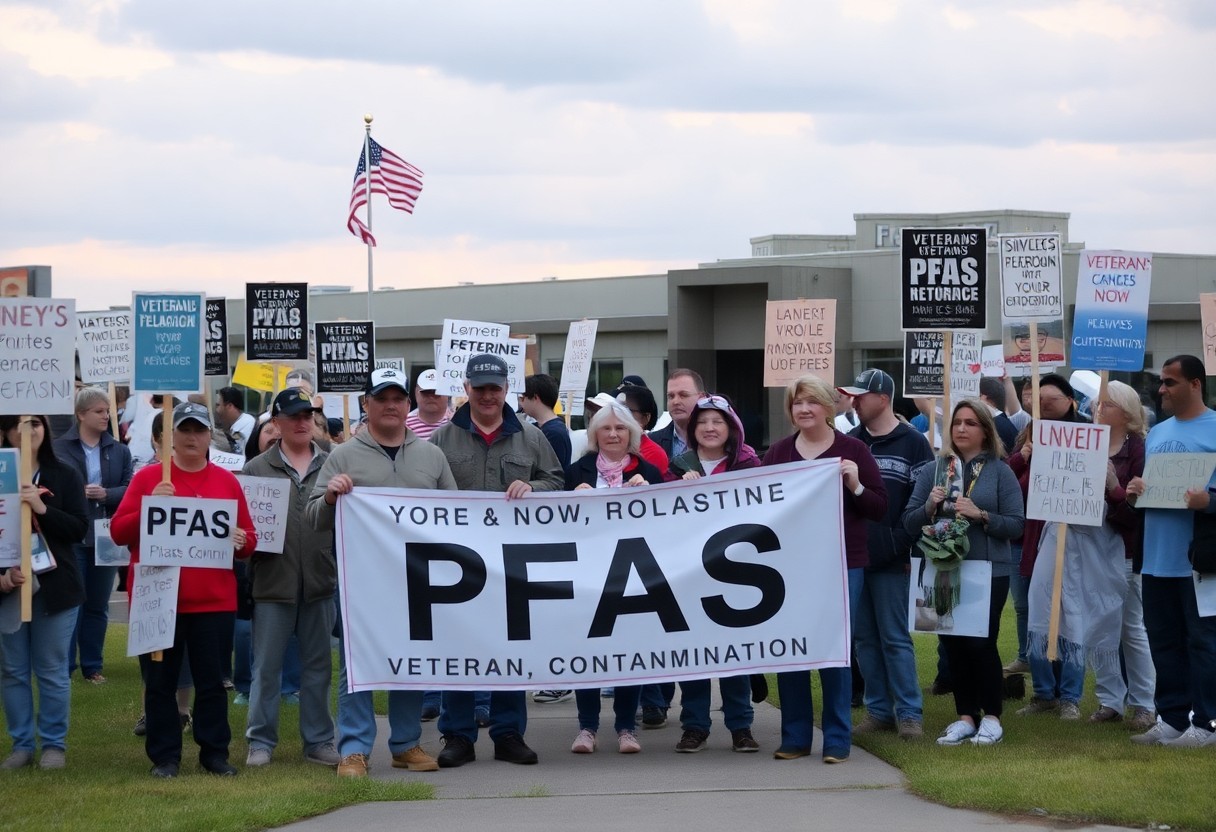Most residents in New England are becoming increasingly aware of the dangers posed by PFAS (per- and polyfluoroalkyl substances), often referred to as “forever chemicals.” These man-made substances have been linked to serious health risks, making it imperative for you to understand the legal implications in your state. This guide will provide you with a comprehensive overview of state-specific regulations, helping you navigate the complex landscape around PFAS in your area. Stay informed and empowered to protect your health and the environment.

Types of PFAS
To gain a better understanding of PFAS, it is important to differentiate between its various types. The two primary classes of PFAS are:
| Perfluoroalkyl Substances | These compounds contain fully fluorinated carbon chains. |
| Polyfluoroalkyl Substances | These compounds have partially fluorinated carbon chains. |
| Environmental Persistence | PFAS are known for their resistance to degradation. |
| Health Risks | Exposure may lead to serious health concerns. |
| Regulatory Attention | Governments are actively regulating PFAS usage. |
Recognizing the types of PFAS can help you understand their implications for your community and health.
Perfluoroalkyl Substances
Any discussion regarding PFAS often begins with perfluoroalkyl substances, which are a subset of these compounds characterized by a fully fluorinated carbon chain. You will find that these substances have been used in a wide range of consumer products, such as stain-resistant fabrics and non-stick cookware. Their widespread application has raised increasing concern about potential health risks associated with long-term exposure.
Polyfluoroalkyl Substances
Perfluoroalkyl substances differ significantly in their chemical bonding and structure compared to their counterparts. These compounds consist of partially fluorinated chains, which makes them more reactive and possibly more hazardous. You should take note that while some polyfluoroalkyl substances have been phased out, others remain in circulation and can pose a risk in your environment.
Understanding polyfluoroalkyl substances is crucial, as they may break down into more persistent PFAS over time. The reactivity of these compounds can contribute to various environmental issues and potential health effects, including impacts on the immune system and hormonal disruptions. As you navigate the challenges posed by PFAS, being informed about these specific substances will empower you to advocate for safer practices and policies in your community.
State-Specific Laws
Any discussion of PFAS regulations requires understanding how individual states address these chemicals. Each state in New England has its own set of rules and legislation, which can vary significantly in scope and enforcement. This guide will help you navigate the specific laws in Massachusetts, Connecticut, Rhode Island, New Hampshire, Maine, and Vermont to ensure you are well informed about the legal landscape related to PFAS.
Massachusetts
Laws in Massachusetts regarding PFAS have gained attention, particularly as the state has implemented regulations to limit exposure. The Massachusetts Department of Environmental Protection has established drinking water standards for PFAS, aiming to protect public health. Additionally, legislation is being considered to require manufacturers to disclose the presence of these chemicals in products.
Connecticut
Any efforts in Connecticut are characterized by legislative measures aimed at reducing PFAS contamination. Recently, the state has set drinking water standards for several PFAS compounds, underlining its commitment to addressing public health concerns. This includes regulating the use of PFAS in certain products and requiring clean-up efforts at polluted sites.
Another key initiative in Connecticut is the establishment of a PFAS Task Force, which focuses on evaluating and recommending policies to mitigate PFAS risks. You may find that these developments provide important insights into how the state is working towards regulating PFAS usage and protecting residents from exposure.
Rhode Island
Assuming you reside in Rhode Island, you will find that the state has enacted legislation addressing PFAS contamination. In 2020, Rhode Island established drinking water standards for several PFAS, demonstrating a proactive stance on public health. These regulations are designed to limit exposure and ensure safe drinking water for all residents.
To further enhance its approach, Rhode Island has initiated monitoring programs for PFAS levels in drinking water supplies. This ongoing surveillance allows for timely responses to contamination incidents, ensuring that you and your community are informed about potential hazards and have access to safe water.
New Hampshire
Assuming you are in New Hampshire, you should be aware that the state has also taken significant steps to combat PFAS pollution. New Hampshire has established drinking water standards and has been actively working to reduce PFAS levels in the environment through various cleanup efforts and regulations.
With ongoing initiatives, New Hampshire aims to expand its testing and monitoring of PFAS in water sources and soil. You may observe increased public awareness campaigns designed to educate citizens about proper disposal methods and the dangers associated with PFAS exposure.
Maine
Even in Maine, PFAS laws are gaining traction as the state approaches the issue with a comprehensive strategy. Maine has enacted regulations regarding the use of PFAS in consumer products and is working towards setting drinking water standards to protect health and safety.
Island approaches to education and prevention are being prioritized, enabling you to participate in community discussions and initiatives aimed at reducing PFAS exposure. These collective efforts will ensure that you have access to clear information on protecting yourself and your family from hazardous substances.
Vermont
Massachusetts has been particularly active in addressing PFAS concerns, with Vermont also following suit. The state has implemented strict drinking water quality standards for PFAS, and legislation has been introduced to regulate these substances in various products.
Plus, Vermont’s commitment to transparency and public health means that you can self-advocate. The state actively publishes data on PFAS levels, empowering you to stay informed about potential risks in your environment and advocate for safer practices and regulations.
Key Factors in PFAS Regulation
Unlike other environmental chemicals, PFAS regulations are influenced by unique factors that shape their management across New England. Key elements include:
- State laws variations
- Public health initiatives
- Industry responses to regulation
- Community advocacy efforts
Perceiving these nuances is important for understanding the diverse landscape of PFAS legislation in your area.
Health impacts
PFAS exposure has been linked to serious health risks, including liver damage, immune system effects, and developmental issues. You should stay informed about ongoing research and evolving health guidelines to ensure your family’s safety.
Environmental concerns
Concerns surrounding PFAS center around their persistence in the environment and potential contamination of water supplies. You must be aware of how PFAS can move through the soil and enter your drinking water, posing risks to both your health and local ecosystems.
This widespread contamination leads to long-term ecological damage, affecting wildlife and disrupting food chains. Understanding these implications allows you to participate in local discussions about remediation efforts and advocate for cleaner environmental practices in your community.
Economic implications
Implications of PFAS regulation are significant for local economies as communities grapple with the costs of remediation and compliance. This can affect your property values and local industries dependent on clean water.
Factors such as the need for infrastructure improvements to address PFAS contamination, along with potential liabilities faced by manufacturers, further complicate economic considerations. Being proactive in understanding these matters can help you advocate for appropriate policies that balance economic growth and environmental health.
Tips for Addressing PFAS Issues
Many individuals and communities facing PFAS concerns can benefit from these tips:
- Conduct thorough investigations into PFAS contamination.
- Engage proactively with local health departments.
- Advocate for transparency from industries.
- Explore available legal remedies.
- Educate yourself and others on PFAS risks.
Perceiving these strategies will empower you to tackle PFAS challenges effectively.
Identifying contaminated sources
The process of identifying contaminated sources of PFAS involves investigating potential sites like industrial areas, airports, and landfills. Testing water and soil in suspected areas can reveal the presence of these harmful substances, allowing for timely intervention.
Engaging with local authorities
You play an important role in addressing PFAS issues by engaging with local authorities. Collaboration can drive policy changes and ensure your concerns are prioritized.
Tips for effective engagement include organizing community meetings to discuss PFAS contamination, requesting public access to testing results, and forming partnerships with local environmental organizations. By presenting a unified voice, you can encourage local officials to address PFAS-related policies and remediation efforts.
Community awareness and advocacy
Some communities have seen significant progress in addressing PFAS issues through increased awareness and advocacy. Educating residents about potential health risks and property implications creates a more informed population.
Local advocacy groups can effectively lobby for stricter regulations and cleanup initiatives. Hosting workshops and information sessions helps raise awareness about PFAS exposure, empowering residents to take an active role in advocating for safer environments in your community.
Step-by-Step Legal Guidance
Now that you are aware of the PFAS issues affecting New England, it’s important to have a clear strategy when navigating the legal landscape. The following table outlines crucial steps you should take:
| Step | Description |
| 1. Understanding Your Rights | Familiarize yourself with federal and state regulations regarding PFAS contamination. |
| 2. Navigating the Legal Process | Follow specific protocols to file complaints or lawsuits related to PFAS exposure. |
| 3. Seeking Legal Representation | Engage a qualified attorney to assist with your case. |
Understanding Your Rights
Rights regarding environmental contamination and personal injury can empower you to take action. Your state laws may provide avenues for compensation or remediation, giving you the ability to hold responsible parties accountable. Knowing your rights is your first step in pursuing any claims related to PFAS exposure.
Navigating the Legal Process
An effective legal journey requires understanding the steps involved in bringing a case forward. It typically includes investigating the scope of contamination, gathering evidence, and filing appropriate legal documents in your jurisdiction. Timing and adherence to regulations are key components to ensuring a smooth process.
Legal considerations vary by state and may involve multiple agencies, particularly if you are filing against a corporation or government entity. You should collect pertinent evidence, including health records and environmental testing results, to support your claims. Additionally, staying informed on deadlines for filing your case will strengthen your position.
Seeking Legal Representation
Representation from an experienced attorney can significantly impact the outcome of your case. Specialists in environmental law can navigate the complexities of PFAS litigation, ensuring that your rights are vigorously advocated and protected.
Legal professionals can help you understand the intricacies of your specific situation, providing valuable insights on potential compensation, class actions, or settlements. Their expertise is vital in presenting a compelling case, evaluating the strength of your claims, and formulating a strategic approach tailored to achieve favorable results.
Pros and Cons of PFAS Regulation
After evaluating the landscape of PFAS regulations, it’s vital to weigh both sides of the argument to understand the implications for your community and health. Below is a summary of the pros and cons associated with PFAS regulation:
| Pros | Cons |
|---|---|
| Improves public health | High compliance costs |
| Increases access to clean water | Potential for litigation |
| Encourages innovation in alternatives | Limited regulatory frameworks |
| Boosts consumer confidence | Disruption to industries using PFAS |
| Reduces long-term environmental impacts | Uneven state regulations |
Benefits of Stricter Regulations
Assuming stricter regulations are implemented, you will observe significant improvements in public health outcomes. By reducing or eliminating PFAS exposure, you can protect vulnerable populations, notably children and pregnant women. Additionally, cleaner water sources will enhance your overall quality of life and foster greater environmental sustainability.
Drawbacks and Challenges
If stricter regulations are enforced, you may encounter various obstacles that complicate implementation. These can include financial burdens on industries required to adapt and the potential for added legal battles over compliance. Additionally, navigating the complexities of varying state regulations can create confusion and delay action.
This landscape of drawbacks and challenges may pose significant hurdles in the effective regulation of PFAS. Compliance costs could be a heavy burden for industries, leading many to seek legal redress rather than adapt to the new standards. Furthermore, since PFAS regulations are often inconsistent across states, you may find yourself dealing with a patchwork of laws that complicate your understanding of the situation. Addressing these barriers requires collective action and informed advocacy at the community level, ensuring that your voice is heard in the regulatory process.
Final Words
To wrap up, understanding the state-specific regulations and legal frameworks surrounding PFAS in New England is imperative for you, whether you’re a resident, business owner, or advocate. Each state has its own approach to managing these substances, impacting everything from public health to environmental protection. By staying informed and proactive in your local context, you can better navigate the complexities of PFAS laws and contribute to efforts aimed at minimizing their risks in your community.



















